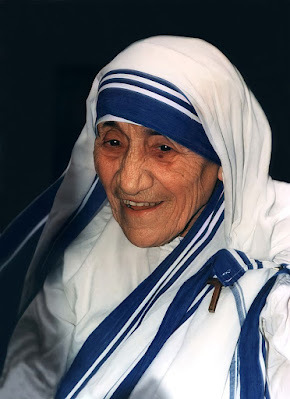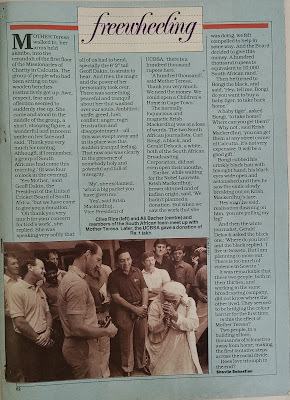When a group of South Africans met Mother Teresa


COLUMN: TUNNEL OF TIME
By Shevlin Sebastian
Mother Teresa walked in, her arms held akimbo, onto the verandaof the first floor of the Missionaries of Charity in Calcutta. It was inNovember, 1991. The group of people who had been sitting on two wooden benchesinstinctively got up.
Awe, respect, fear and affection seemed to suddenly rise up.She came and stood in the middle of the group, a short, stooping figure, with awonderful and innocent smile and said, ‘Thank you very much for coming. If Iremember right, a group of South Africans had come this morning.’
It was 4 p.m.
‘Yes Mother,’ said Geoff Dakin, the President of the UnitedCricket Board of South Africa (UCBSA). ‘But we have come to give you adonation.’
(This tour marked South Africa’s return to internationalcricket after decades of isolation due to apartheid. The first one-day matchwas at the Eden Gardens, just days earlier. As for the Missionaries of Charity MotherTeresa founded it in 1950. Today, there are branches in 139 countries.)
‘Oh, thank you very much for your concern for God’s work,’she replied.
She was speaking so softly that all present had to bend, especiallythe 6’2” Geoff, to hear what she was saying. And then the magic and the powerof her personality took over.
There was something peaceful and calm about her that washedover all of us. Ambition; greed; anger; frustration -- all this was swept away.In its place was this tranquil feeling. It was clear all of us were in thepresence of somebody holy, powerful and full of integrity.
‘My, what a big packet you have given me,’ she exclaimed.
‘Yes,’ said Krish Mackerdhuj, Vice-President of UCBSA. ‘There’sa hundred thousand rupees.’
‘A hundred thousand,’ said Mother Teresa. ‘Thank you verymuch. We need the money. We could open a Children’s Home in Cape Town.’
The normally loquacious and magnetic Krish was at a loss ofwords.
The two South African journalists, Carl Bongj and GeraldDekock -- one black, one white, of the South African Broadcasting Corporation, stoodsilently.
Earlier, while waiting for the Nobel Laureate, Krish, brown-skinnedand of Indian origin, said, ‘We hadn’t planned a donation. But when we saw thework that she was doing, we felt compelled to help in some way. And the Boarddecided to give this money. A hundred thousand rupees is equivalent to 10,000South African rand.’
Then he turned to Bongj, and said, ‘Hey, tell me, Bongj, doyou want to buy a baby tiger, to take back home.’
‘A baby tiger to take home?’ said Bongj. ‘Where can you getthem?’
‘You can get them at any street corner of Calcutta,’ saidKrish. ‘It’s not very expensive. It will be a good gift.’
Bongj rubbed his hair with his right hand, his eyes wide openand astonished, and then he saw the smile slowly breaking out on Krish’s face.
‘Hey man,’ he said, as realisation dawned on him. ‘You’repulling my leg!’
And then Gerald asked Bongj: ‘Where do you live?’
Bongj replied, ‘I live in Soweto, but I’m planning to moveout. There’s too much violence in Soweto.’
It was remarkable that these two men, both in their thirtiesand working for the same broadcaster, did not know where the other lived.
They seemed to be bridging the colour barrier for the firsttime.
Was this the effect of Mother Teresa?
Two people, in a building of love, thousands of kilometresaway from home, making the first tentative steps across the racial divide.
(Published in Sportsworld, November 20, 1991)



